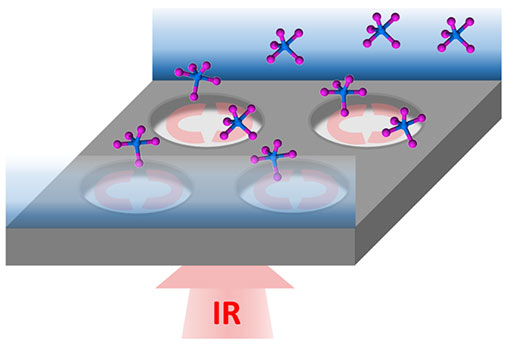Enhancing the Infrared Detection of Molecular Fingerprints
A new approach, developed in York, significantly enhances molecular detection in dilute solutions and opens exciting new possibilities in terms of disease diagnosis.
The ability to determine the molecular composition of liquid mixtures is needed across a wide range of science, from monitoring chemical reactions to the analysis of biomedical samples. However, the complexity of such systems, and the low levels of some analytes of interest, can make this analysis particularly challenging.
Infrared (IR) spectroscopy is a powerful analytical tool because the signals act as highly distinctive ‘fingerprints’, based on the precise details of the molecular structure. Unfortunately, applications of IR spectroscopy are limited by its relatively low sensitivity.
In order to address this issue, a team based in York led by Professor Neil Hunt in the Department of Chemistry and Professor Thomas Krauss of the School of Physics, Engineering and Technology have taken a surface modification approach.
The team produced a series of silicon surfaces patterned on the micro-scale (smaller than the thickness of human hair). When samples are placed on these surfaces, the IR signals are enhanced by 10-100 times, thus allowing molecules to be detected at much lower concentrations than was previously possible.

Importantly, the enhanced electric field associated with these unique patterned surfaces, that creates the enhancement in signal intensity, extends deeper into the material being analysed than currently used metal surfaces. This means that the IR signals of dilute liquids can be enhanced and properly analysed for the first time.
Dr Soheila Kharratian, a postdoctoral research associate in the Hunt lab, and first author on the paper explains: “Being able to analyse the composition of dilute liquids with IR is a very significant breakthrough. In the future, this might find application in the analysis of blood samples.
"For example, it may be possible to precisely monitor the levels of pharmaceuticals and their metabolites in the bloodstream. Alternatively, specific molecules present within the blood may even act as detectable fingerprints of certain diseases.”
The research paper has been published in Chemical Science.